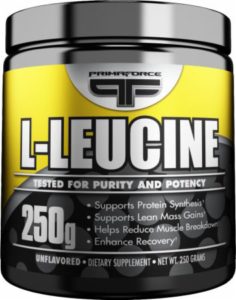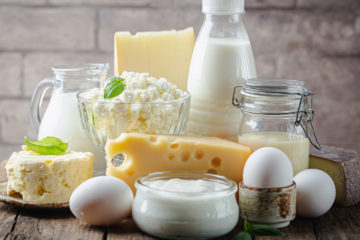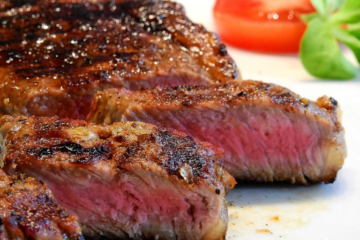It has been accepted in the sports nutrition world for some time that taking 3g of the amino acid, leucine, along with 20 – 25g protein after intense exercise, will result in faster repair of muscles and greater muscle growth.
This is true, but there is a dark side to this that few body-builders realise. Read on to learn more of the facts.
The most popular protein supplement is whey protein isolate (WPI). Whey is a cheap leftover product from cheese-making. It contains concentrated protein (the fat of milk is left in the cheese) as well as a substance called leucine – much more than in either soy, pea or brown rice proteins. The high leucine content of whey is one reason experienced body-builders favour it.
What is leucine?
Foods containing protein break down in the stomach or small intestine into chains of atoms called amino acids. One of these 20 amino acid chains is leucine. Once broken down, the amino acids can be absorbed through the intestinal wall into the bloodstream. Leucine belongs to a special class of amino acids called ‘branched-chain amino acids’ (BCAAs), together with isoleucine and valine. The ‘branched-chain’ describes the way the atoms are linked together to make their amino acid molecule. These three amino acids reduce muscle damage, preventing it from breaking down during exercise, and this allows faster muscle growth. It’s no wonder that they are big business in the sports nutrition world. Most people in gyms using bodybuilding supplements are downing BCAAs alone or in their protein drinks. 
The problem with leucine, however, is that the mechanism by which it builds muscle is the same mechanism that drives various cancers. Leucine stimulates an enzyme called mTOR. mTOR makes cells grow bigger and reproduce themselves faster. This is how leucine causes more rapid muscle growth. In the same way, it causes more rapid tumour growth. Higher TOR expression is particularly noted in breast and prostate cancer patients. This is one reason there is a link between milk-products (high in leucine) and these cancers.
The new chemotherapy drugs
This year I have the wonderful opportunity to study under and be mentored by the current President of the Oncology Association of Naturopathic Physicians, Lise Alschuler. This month we have been looking at each class of chemotherapy drug, and what peer-reviewed research shows about how complementary therapies, such as nutrition, can both make these treatments more effective and lessen or eliminate common side effects of each, such as nausea, peripheral neuropathy and long-term cardiac problems.
A lot of research is now going into new chemotherapy drugs called Molecular Targeted Therapies. One particular class of these newer cancer therapies are called ‘mTOR inhibitors’. These particular therapies (Everolimus/Afinitor and Temsirolimus being the most commonly used) inhibit the mTOR enzyme so it is hindered from causing cell growth and division of cells. This is showing evidence to slow down cancer growth and is being offered to patients with more aggressive breast cancers (Advanced ER + HER2), advanced pancreatic tumours and advanced renal cell (kidney) cancers.
Does the sports supplement industry have much to do with health?
As it turns out, the sports nutrition world is encouraging the use of products that increase the actions of mTOR, while on the other hand, the oncology world is developing drugs to slow down this enzyme’s action in order to save people’s lives.
We have to question whether the current trend of body-builders to be ‘BIG’ is actually healthy, and what will be the longer-term repercussions of this holy grail.
Questions to ask before using any drug or supplement:
Before using body-building supplements, we need to first understand their mechanism of action. Whatever changes you make in your body will affect several other body functions. Just like damming a river upstream has many far-reaching effects downstream, in the same way, you can’t do just one thing in the body. This leucine/BCAA product will not only help you build bigger muscles – it may be placing you in a higher risk category for cancer – because it is increasing one of the very mechanisms that cause the growth and spread of tumours.
Is a smaller amount of leucine safe? Are plant proteins safe?
 All leucine causes faster cell growth because it stimulates the mTOR enzyme. Concentrated sources of leucine and BCAAs simply stimulate the enzyme to act all the more. We certainly need this enzyme to activate – so we get muscle repair and cell division, but we don’t need it more than the amount nature has packaged in whole foods. Stick to whole foods and you will have a natural safety barrier.
All leucine causes faster cell growth because it stimulates the mTOR enzyme. Concentrated sources of leucine and BCAAs simply stimulate the enzyme to act all the more. We certainly need this enzyme to activate – so we get muscle repair and cell division, but we don’t need it more than the amount nature has packaged in whole foods. Stick to whole foods and you will have a natural safety barrier.
(Whether milk is a whole food suited for humans or whether it is better suited for baby cows is a topic for another discussion.)
Table 1: Leucine amounts in some common plant foods.
RDI/RDA: Leucine 2.5g adults / Protein 46 – 58g/day adults (av.)
Food Amount Leucine Protein
Black beans, 1/2 cup, drained 0.6g 7.1g
French lentils, 1/2 cup 0.6g 8.9g
soy milk, 1 cup 0.6g 7.8g
tofu, 4 Tbsp, cubed 0.6g 7.5g
broccoli, 2 cups, cooked 0.5g 7.4g
mixed lettuce leaves, 3 cups 0.2g 2.5g
chickpeas(garbanzos), 1/2 cup, drained 0.4g 5.8g
spinach, 1/2 cup, cooked 0.2g 2.7g
brown rice, 1/2 cup, cooked 0.2g 2.8g
quinoa, 1/2 cup, cooked 0.2g 4.1g
BCAA protein blend, 1 serve 2.9g (117% RDI) 25g
Pure Leucine supplement, 30g serve 28.3g (1133% RDI) -
Note: Leucine amounts in meat, tuna and eggs are similar to that
of beans and lentils. It is the protein (and fat) amounts of
animal foods that are higher per gram.
How can I grow muscle without leucine/BCAA supplements?
On a whole foods (no body-building supplements) diet, you will be depending on gaining muscle by using a muscle-building (weights) programme with commitment, allowing muscle groups time for rest and repair between sessions and by paying attention to eating your larger protein meals (higher leucine foods) of the day AFTER you have done weight-bearing exercise, with 20 – 25g protein in each meal. This is the maximum amount that can be utilised by the body at one time. Optimally, start with such a meal within 30 – 90 minutes after exercise.
Many elite athletes, including strength athletes, reach world standard without using body-building supplements. At this stage, I do not recommend never using them if you are a plant-based athlete, but do weigh up the available evidence before doing so.
See http://www.greatveganathletes.com/torre-washington-vegan-bodybuilder and
Guilt-Free TV YouTube channel https://www.youtube.com/watch?v=uK4ML8GVKhk



0 Comments